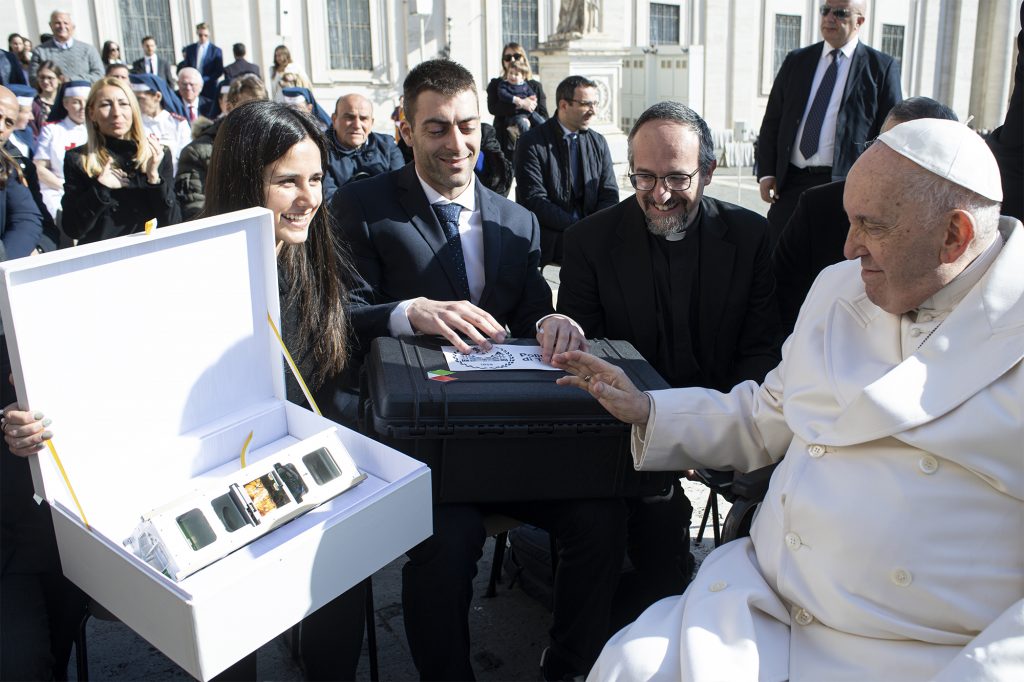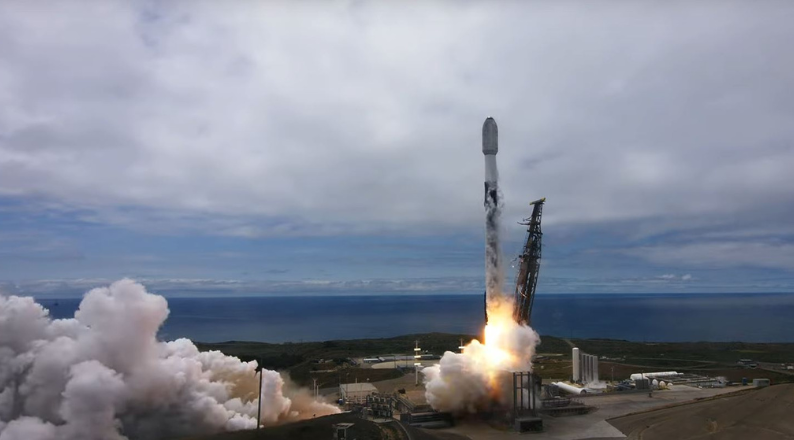(ZENIT News / Rome, 06.13.2023).- The Spei Satelles mission has successfully launched from the U.S. base in Vandenberg, California, and in the coming days, it plans to deploy the CubeSat into orbit, carrying Pope Francis’ message of hope contained in the Nanobook titled «Why are you afraid, do you still have no faith?»
Coordinating the Spei Satelles mission, at the urging of the Holy See’s Dicastery for Communication, is the Italian Space Agency (ASI) in collaboration with the Polytechnic University of Turin. Researchers and students from the Department of Mechanical and Aerospace Engineering at the Polytechnic University of Turin have built the CubeSat 3U. The CubeSat, containing the Nanobook created by the National Research Council (CNR), will be placed in orbit using the ION orbital transfer vehicle from Italy’s D-ORBIT, which was launched by a Falcon9 rocket.
Although small in size, the satellite and the Nanobook carry great significance. The name and logo of the Space Mission itself reflect the desire to inspire hope, creating a symbol in the sky to promote fraternity and sharing on Earth—the driving forces behind all possible hope.

This initiative symbolizes the Pope’s message from March 27, 2020, when the Statio Orbis in St. Peter’s Square encouraged the world to have hope.
The project involved the Italian Space Agency, the National Research Council, The Polytechnic of Turin, the Instituto para el Diálogo Global y la Cultura del Encuentro – IDGCE, the Salesian University Institute of Venice – IUSVE, and the Digital Apostolate of the Archdiocese of Turin.
The heart of the mission lies within the satellite, which carries the Nanobook containing the Pope’s words, a transmitter, and a memory chip that symbolically encourage people to have hope and take action to share hope.
After months of dedicated work and immense passion, the CubeSat 3U constructed by students at the Polytechnic University of Turin is now en route to a heliosynchronous orbit, approximately 525 km above the Earth’s surface. The rectangular prism, measuring 34x10x10 centimeters and weighing less than 3 kilograms, encompasses state-of-the-art systems blessed by Pope Francis during his audience on March 29. Alongside flight and telemetry equipment, this small messenger carries various «tools» of hope and peace.

The Spei Satelles Mission carries a Nanobook created by the Institute of Photonics and Nanotechnology at the National Research Council. Within this microscopic silicon slab, the text of the book titled «Why Are You Afraid? You Still Have No Faith» is contained, which compiles the Pope’s reflections and images during the challenging days of the pandemic, particularly highlighting the Statio Orbis on March 27, 2020. By launching the Nanobook into space, it aims to serve as a symbol of hope in the sky, invisible to the eyes but not to the hearts of those who wish to embark on a future of fraternity and sharing, drawing inspiration from those moments.
The satellite’s voice will be transmitted through a transmitter operating within the amateur radio band, on the frequency of 437.5 MHz with modulation: GMSK at 9600 bit/s and protocol: AX.25. It will broadcast messages derived from the Pontifical Magisterium on hope. At sunrise in different parts of the world, individuals will have the opportunity to receive words of comfort and encouragement along the paths of hope.
Finally, the Spei Satelles mission also involves all people on Earth who wish to participate. Since March 27, 2023, the day www.speisatelles.org was launched, hundreds of individuals from all over the world have joined the project by registering on the website and obtaining a symbolic boarding pass. Each person has «boarded» by committing to perform an act of mercy on Earth. This includes men, women, youth, and children. For example, María from Mexico pledges to display messages of peace in her store, 17-year-old Andrea from the U.S. pledges to write a letter of gratitude to her teachers for their love and dedication to their mission, and Don Renato from Italy pledges to help children express themselves online with intelligence, respect, and empathy. Given the success and the educational potential of membership, even though the launch has already taken place, it will still be possible to sign up, and names will be remotely written on the memory in orbit through the ground control station.
Supported by their respective institutions, those involved express their excitement and satisfaction as participants in the mission. They had the opportunity to meet Pope Francis during the blessing of the satellite, which further encouraged them.

Silvia Natalucci, head of ASI’s Micro and Nanosatellites Unit, which coordinated the mission, stated, «Realizing this mission in such a short time was quite a challenge, but we succeeded thanks to the determination of the young team from ASI and the Polytechnic University of Turin. They pursued the dream of launching this small satellite into space, which, in line with the Latin etymology of its name, will safeguard the message of trust and hope that Pope Francis wanted to offer to a world suffering from the pandemic. It is a perfect example of how the peaceful use of technology can contribute to the creation of a shared culture of peace and hope among people.»
Sabrina Corpino, the leader of the Polytechnic students who built the satellite in just five months, said, «After months of intense work, we eagerly awaited the moment when Spei Satelles would reach the launch pad. Once the launch took place, the students realized that their hard work had truly reached space, and they had contributed to the creation of a real space mission. They have already learned so much, and in the coming days, they will begin on-orbit operations, collecting data to validate the design, mathematical models, and analyses conducted in our laboratories. This will further enhance our technical and scientific knowledge and help spread words of hope for our future. For now, let us take a moment to pause and share in the joy of achieving this significant milestone in the mission. For engineers working in the space field, launching a satellite into orbit is always an exhilarating event. When something you have built is on the launcher, it becomes an experience you will never forget.»
Andrea Notargiacomo, the first researcher at the National Research Council’s Institute of Photonics and Nanotechnology who created the Nanobook, expresses, «It is incredibly satisfying to be able to help spread such a powerful message of universal hope through small objects like the CubeSat micro-satellite and the Nanobook contained within it. The Spei Satelles initiative represents a unique blend of science, technology, culture, and faith, showcasing how the collaboration between different skills, ideas, and thoughts can generate remarkable innovation while also being a source of human and social enrichment.»
Marica Padoan from IUSVE, the designer of the mission logo, shares her perspective, «Creating a logo is like contributing to the identity and imagery surrounding the mission. The feedback I have received regarding my small contribution to this project confirms how hope and inclusion can be conveyed and suggested even through visual symbols.»

Gianluca Cerasola, who sparked the initial conversations about the idea of taking the Statio Orbis Message into space after the film Starman, remarks, «Producing documentaries about space, featuring characters like astronaut Luca Parmitano, has touched the minds and hearts of many, immersing them in the mystery of the reality that surrounds us and instilling a desire to cherish it. Witnessing Spei Satelles now in orbit, carrying this profound message, is something that inspires more than the idea of making a film; it is a call to hope, an invitation to change our way of life.»
Fr. Luca Peyron, who, along with the Digital Apostolate team, coordinated the cultural and pastoral aspects of the mission, states, «Spei Satelles was and continues to be a magnificent space adventure shared with young people, focusing on them and involving them above all. Young people not just in a chronological sense but also in a spiritual sense, those who wish to remain youthful because they continue to generate vitality and hope for the people they encounter.»
Lastly, Msgr. Lucio A. Ruiz, who oversaw the entire project on behalf of the Holy See as Secretary of the Dicastery for Communication, expresses, «Pope Francis’ message in space serves as a sign and representation of tenderness and blessing for the world. Today, this project becomes a reality thanks to the numerous institutions and individuals who have chosen to join forces and collaborate. The vastness of space always sparks our imagination, and now we all need to dream together again, hoping that the much-awaited peace will return to the world by involving all of us. I see this unity and communion as a significant initial fruit and a sign of hope. Working together to bring this sign of hope strengthens our bonds of friendship and brotherhood, truly making us ‘Fratelli tutti»



